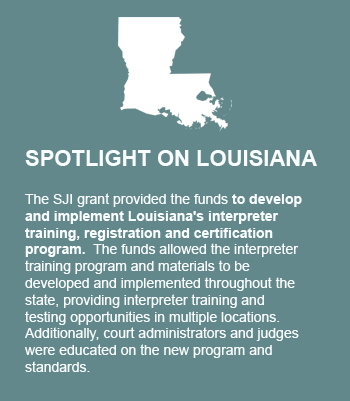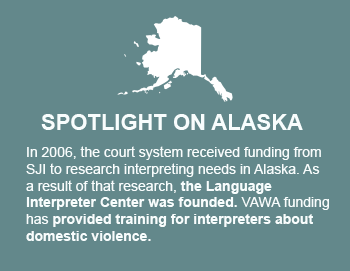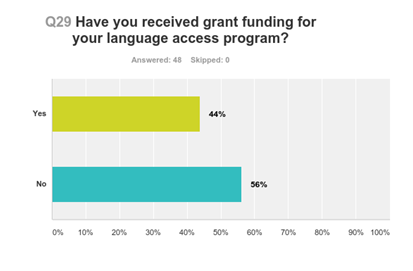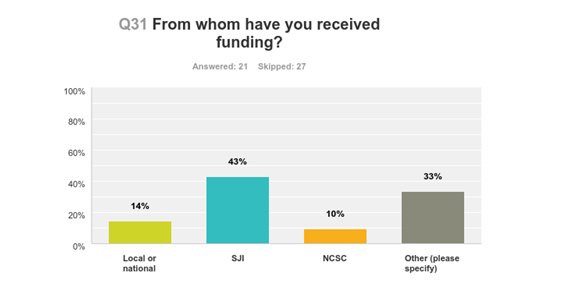Develop and implement strategies to secure short-term and long-term funding for language access services.
Five years ago at the Summit, jurisdictions identified funding as a major priority area. Jurisdictions pointed to funding issues, in particular obtaining funding, as a major barrier to improving their language access services. Due to the ongoing economic crisis that was occurring at that time and the negative impact on court funding, prospects for funding support either through legislative, local, and/or national sources were inadequate. Participating and hosting entities, such as SJI and NCSC, voiced their commitment to supporting jurisdiction’s efforts to increase their funding.
The Summit dedicated extensive discussions on recommendations on strategies to obtain funding. Summit participants engaged in workshops and planning sessions where they prioritized areas and pinpointed initiatives in need of support, including both long-term and short-term funding.
Funding Received
Currently, just under half of jurisdictions (44%) report that they have received support in the form of grant funding. (Fig. Q29.) This is an increase of funding compared to five years ago when NCSC surveyed jurisdictions. In 2012, 36% of jurisdictions surveyed in the Pre-Summit Assessment reported receiving grant funding.[1]
While the nation reportedly has now come out of the crisis coined the “Great Recession,” funding at local, state, and national levels remain challenging. Therefore, this reported rise in grant funding while only 8 percentage points is a significant showing, as support has not only remained steady but has actually increased. This continuity in support largely can be attributed to the efforts of SJI as described below.
Sources of Funding
Next, the survey identified the sources of funding. Jurisdictions reported receiving funding from three primary sources: SJI, local or national sources, and NCSC[2]. Forty-three percent of jurisdictions reported in the survey that they received funding from SJI. SJI has had a significant impact on supporting jurisdictions across the country in funding areas that have led directly to improvements. SJI has carefully and thoughtfully identified areas of need to fund that would result in the greatest level of impact and progress.
Other sources of funding that jurisdictions listed were:
- All of the above as listed in question choices.
- Local, National, NCSC, SJI
- SJI; State Bar of Georgia; Georgia Asian Pacific Bar Association
- DOJ, ABA
- Nevada Attorney General's Office
- Court Improvement Project, VAWA
Type of Funding
Next, the survey sought to identify the types of funding that are available and have been awarded.
Q30 “What type of funding (i.e., project supported) have you received?”
Jurisdictions reported that they received funding that supported a variety of programs and projects, ranging from specific needs to program-wide needs. Funding was used toward training, interpreter recruiting, technical support, translation of documents, forms, and online resources, and general technical assistance projects.
Training
- Grant to identify and recruit LOTS interpreters.
- We received funding from SJI to support the development of various training projects.
- Language-intensive training to interpreters (in languages with insufficient interpreters) who have performed very well on the NCSC oral exam but fell just short of passing
- We have received a JAG grant from the Tennessee Office of Criminal Justice Programs to recruit interpreters into our credentialing program.
- Louisiana received a technical assistance grant from SJI to develop and implement an interpreter training and registration program.
Translation Efforts
- SJI Grant award to assist with forms translation efforts in 2007.
- VAWA funding for translation of forms.
Technical Assistance
- Technical Support Grants: 1) stakeholder surveys, 2) language access training for judges and employees, 3) courthouse language identification tools, 4)training for interpreters of languages of lesser diffusion, 5) public counter language access, and 6) technology to deliver services.
- Support in the form of SJI technical assistance (expected summer 2017).
Miscellaneous Comments
- Funding for payment of interpreter services used during child welfare cases, SJI/NCSC technical assistance grant for the assessment of VRI capability.
- With the support of our governor, for the past two years our legislature appropriated $1.5 million to partially reimburse our local courts for their cost in providing qualified interpreters. We have utilized STOP funding for a variety of language access purposes, including translation of Protection from Abuse and Protection Against Sexual Violence and Intimidation court forms, production of English- and Spanish-versions of a video on how to obtain such orders, and interpreter training on vicarious trauma (for interpreters who work on domestic abuse and other traumatic cases).
- BJA Grant to start our program; STOP Grant to translate Civil DV forms and to host trainings for interpreters working in DV and Sexual Assault settings; Marathon Co. Local Bar Grant to publish a Hmong legal glossary; WI State Bar foundation grant to host a training for interpreters working in refugee languages; Refugee Resettlement Grants (multiple) to provide scholarships for candidates of refugee languages to attend orientation and take written test through our State Dept of Children and Families; Funding from our Children Courts Improvement Program to translate child abuse and neglect forms; TA grant from NCSC-SJI to conduct a VRI needs assessment.
- Office of Violence Against Women STOP grant.
Improvements due to Funding
Next, the survey assessed the impact on jurisdictions’ delivery of language access services due to funding.
Q32 Describe how funding has improved or advanced the delivery of
language access services that your jurisdiction provides:
The jurisdictions who received some form of support reported significant improvements attributable to the grants they have received. Jurisdictions described specifically how funding has improved or advanced the delivery of language access services. Notably, several states reported that grant funding helped them start or kick-off particular initiatives or programs:
- Funding was extremely helpful to kick-start necessary translation of vital court forms.
- The funding helped our state get the Foreign Language Interpreter Program off the ground.
- We have been able to use funding from various sources to start our program, recruit new candidates, train existing candidates, and provide continuing education for certified interpreters; we have used funding to create resources for LEP users such as the Hmong legal glossary as well as translated forms.
Other improvements included training, recruiting efforts, translation of vital documents and forms, outreach efforts, among other initiatives:
 Has helped support efforts to identify and recruit LOTS interpreters; SJI has helped drafting of our Model Administrative Protocols.
Has helped support efforts to identify and recruit LOTS interpreters; SJI has helped drafting of our Model Administrative Protocols. - This language specific, intensive training enabled certain individuals to pass the NCSC exam the following year.
- We are able to create and provide bilingual forms in Spanish and Vietnamese. We are planning our next language. Funds pay for a forms design specialist to create the bilingual formats.
- The VAWA funding has assisted the court with interpreting services for DV hearings. The grant has also enabled the court system to develop equivalent DV terminology from English to Yup'ik, an indigenous language primarily in the Bethel Region of Alaska.
- Through various grant funding, the Hawaii state judiciary enhanced its language access services for LEP court users. Through funding the the U.S. Department of Justice, the Judiciary developed information brochures on how to use court interpreters. By explaining the role of the interpreter and providing useful tips for working with an interpreter, this brochure has improved court case management and allowed for more efficient interpreted proceedings. This brochure is also being considered for adoption by a other state courts. The Judiciary also collaborated with the Hawai'i Access to Justice Commission to use grant funding the Commission obtained from the American Bar Association to develop an information flyer to explain the process of requesting an interpreter for a court matter. This information is available in English and 6 non-English languages on the Judiciary's website. This information flyer has helped to educate LEP court users prior to appearing for court proceedings and allowed for more efficient flow of case processing.
- Outreach, training, quality assurance.
- Court forms; signage (made available in 5 most frequent languages).
- We have been able to host a Summit in west Tennessee that targeted our rural counties. This Summit allowed us to train court staff about current language access issues and to recruit interpreters in starting the credentialing process.
- "Improving Access to Justice for Native Peoples in State Courts." "Language Access Basic Training for Judiciary Employees." Funding to create the NM Center for Language Access, which is now our training branch and is self-sustaining through student tuition.
 Certified court interpreter services were provided were funded; translation of forms are available in many languages; VRI assessment to begin in the near future which will allow the courts easier accessibility to certified/registered/qualified interpreters.
Certified court interpreter services were provided were funded; translation of forms are available in many languages; VRI assessment to begin in the near future which will allow the courts easier accessibility to certified/registered/qualified interpreters. - It provided reports and recommendations on the interpreter credentialing program which will improve the level of services provided.
- Provided funding for translation of Domestic Violence Application and Instructions into Spanish, Tagalog, Chinese, and Vietnamese.
- The state funding for reimbursement of local court interpreter expenses has increased local court use of qualified interpreters from our roster. In addition, because we have linked reimbursement under the state grant to use of our data collection system, accurate and complete use of that system has increased. As to the projects done under the STOP grant, translation of court forms & their availability on our website in fillable, bilingual format has improved their usability by court staff who assist LEPs.
- A national expert on interpretation has been contracted to provide post-certification skill development to staff interpreters in order to continue enhancing the quality of language services
- We are working on curriculum development for interpreter training.
- Increased awareness of language access issues and responsibilities; increased interpreter training; increased hard-skills development (use RI technology); increased soft-skills training (LEP customer service); and increased data collection.










